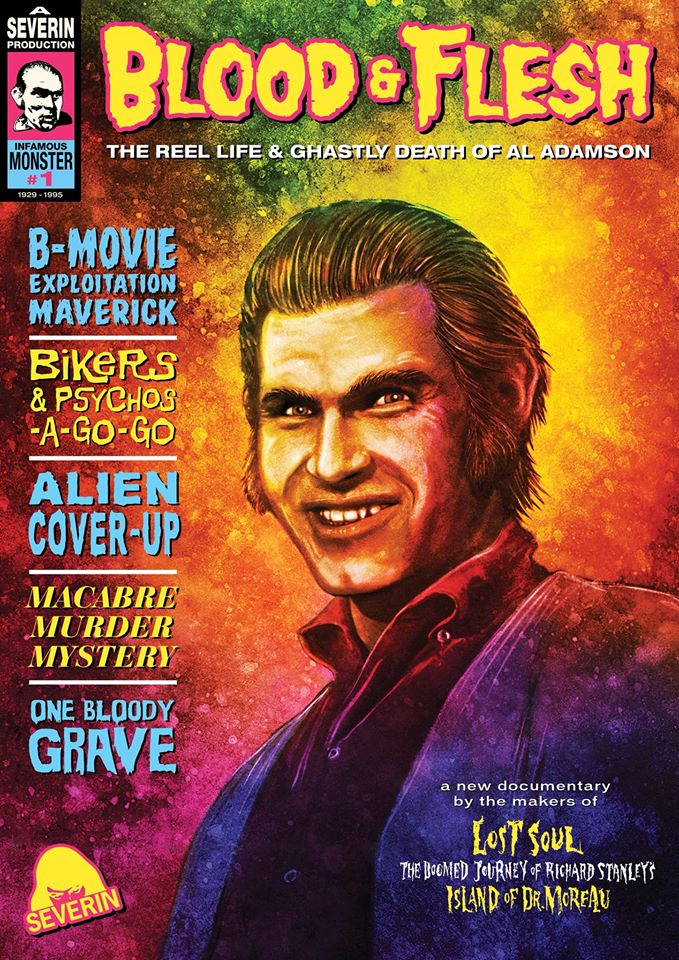
Intimate, uproarious documentary about the B movie legend is also a tragic true crime film
David (LOST SOUL) Gregory’s latest document of cinema eccentricity BLOOD AND FLESH: THE REEL LIFE AND GHASTLY DEATH OF AL ADAMSON, is first and foremost a tragedy. It begins at the end, in 1995, when mainstream media headlines screamed about the grisly discovery of a “horror movie director” who was found entombed in the basement of his California home, the victim of a sociopathic handyman who then went on the lam. It was a sensational finale to a fascinating life making movies whose go-for-broke (in many cases, literally going broke) sensibilities served as a middle finger to good taste. Adamson made pictures that were often rightfully lambasted by the critics, but thrived primarily in the undiscriminating passion pit worlds where cheap, dark fantasy thrills served as background noise to whatever shenanigans were going down in the backseats. Indeed, the gentle, likable director lived to make movies but his sad, cruel death was something that even he couldn’t have imagined.
The son of pioneering Western movie star Denver Dixon, Adamson was literally raised in the movie business and soon fell into directing films in the late ’60s and ’70s, at a time when there really was a healthy market for movies like HORROR OF THE BLOOD MONSTERS, BRAIN OF BLOOD, BLOOD OF GHASTLY HORROR, BLOOD OF DRACULA’S CASTLE and, of course, his most notorious (and perhaps most successful) effort, the deranged DRACULA VS. FRANKENSTEIN. Adamson, along with his frequent collaborator, producer Sam Sherman, unleashed an endless supply of psychedelic skid row schlock , movies made with energy and oddball vision and starring many aging Hollywood legends, like John Carradine, The Ritz Brothers and Aldo Ray. Adamson’s work may not have been “good” by standard definitions of the word, but seen as a body of work it was -and remains – unique, colorful and admirably consistent.
Gregory’s portrait starts with the discovery of Adamson’s body and then dials back the clock to the early days, roping in surviving collaborators, friends, colleagues and family to tell wild tales of making shoestring genre cinema with rules made up as they went along. Laced with charming interview footage of Adamson shot shortly before his murder, the picture also features sincere, often hilarious anecdotes from Sherman, director John “Bud” Cardos, actor “Zandor Vorkov” (a stage name for money man Roger Engel) and iconic cinematographer Vilmos Zsigmond, each who speak with affection and admiration on the inimitable way in which Adamson dove deep into putting these crazy little movies together, sometimes losing money, sometimes making money, but always finding the money to push his weird little efforts to the finish line.
But Gregory doesn’t rely exclusively on talking heads to propel his narrative and his movie is indeed cinematic. Almost every Adamson joint is represented with colorful clips, a cavalcade of cheap gore, bouncing breasts, jiggly bums, scenery chomping line readings and more. The passage where Sherman and company discuss the making of HORROR OF THE BLOOD MONSTERS, which used footage from TAGANI, a black and white Filipino caveman film that was tinted with colors (dubbed Spectrum X in the marketing materials) and explained away by ludicrous plot device, is pure gold. Even better is the section that spotlights cult actor Russ Tamblyn (WEST SIDE STORY, TWIN PEAKS), who was coaxed out of semi-retirement as an artist to star in Adamson’s biker meltdown SATAN’S SADISTS because he needed the money. The script was lousy, so Tamblyn just improvised most of his dialogue, which the affable Adamson allowed and was delighted about. Tamblyn himself is a fascinating figure and it’s fun to see him running rampant on screen in the film, cut with contemporary reflections on those wild times.
But the real soul of the film comes during its final half hour, when Gregory guides us through the widowed Adamson’s slow exit from making movies into his quieter final years, where he began enjoying his newly found cult icon status while focusing on his various businesses (and side obsession with UFO conspiracies). Slowly, surely, FLESH AND BLOOD becomes a wrenching true crime picture, with Adamson’s brother and former housekeeper tracing the events that led to the director’s disappearance and the eventual unearthing of his body, buried in a concrete grave beneath his home. Using news clips, interviews with the detectives who were working the case and, of course Sherman, who was Al’s friend till the end (and perhaps beyond that) all coming together to painfully revisit the sad, brutal end to a kind, gentle man whose shadow loomed large in their lives.
Gregory got his start making a kind of high art out of the DVD special feature via his Severin Films imprint. Indeed he was one of the pioneers of this now standard sidebar. Along the way, he dabbled as a director in features himself (PLAGUE TOWN, THE THEATRE BIZARRE), but it was with his epic Richard Stanley/ ISLAND OF DOCTOR MOREAU feature doc LOST SOUL that he cemented his status as a major filmmaker. BLOOD AND FLESH isn’t as ambitious as that sprawling picture, and it’s not meant to be. Instead, we have an intimate, riotous, affectionate and ultimately profoundly sad essay that is an essential watch not just for horror history fans, but for anyone remotely interested in the waning days of the anti-establishment, Hollywood fringe maverick, of which Al Adamson most certainly was one.
